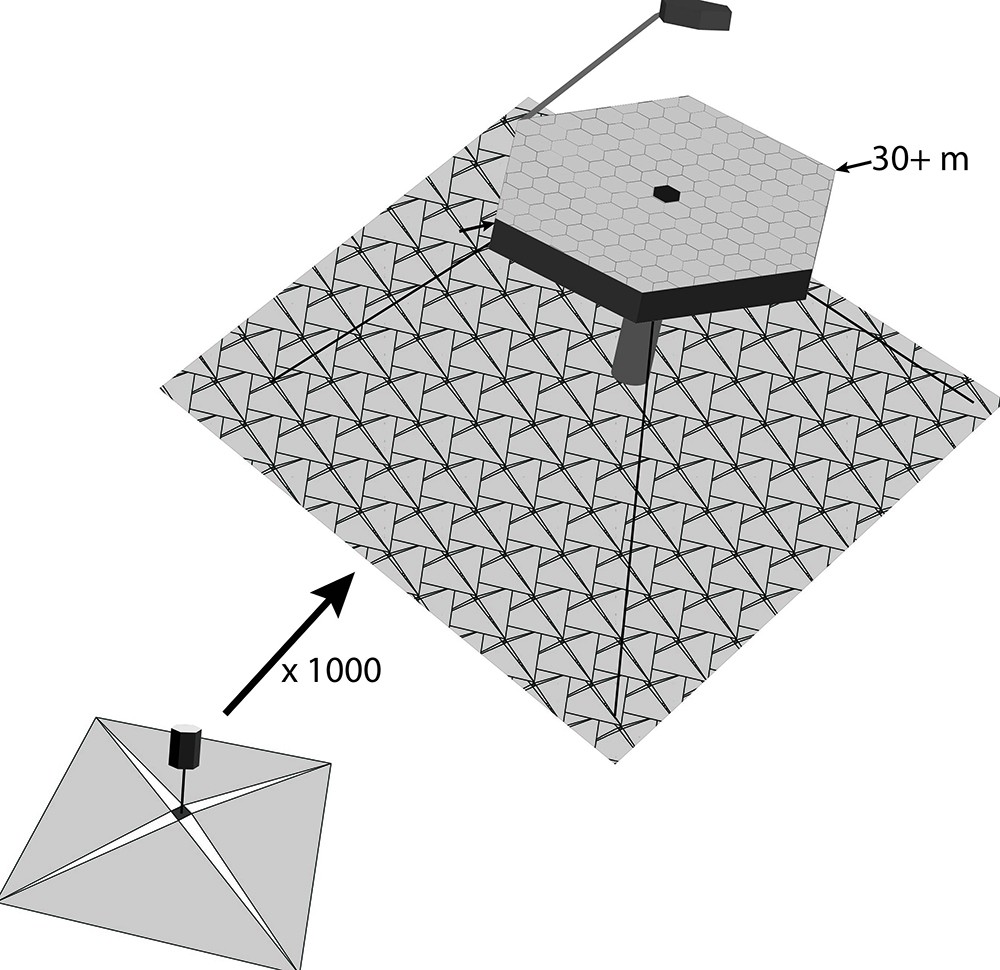NASA has some pretty advanced concepts in mind when it comes to the next generation of space telescopes. These include the
*Transiting Exoplanet Survey Satellite*
(TESS), which recently took to space, as well as the
*James Webb Space Telescope*
(JWST) (scheduled to launch in 2020) and the
Wide-Field Infrared Survey Telescope
(WFIRST), which is still in development.
Beyond these, NASA has also identified several
promising proposals
as part of its
2020 Decadal Survey for Astrophysics
. But perhaps the most ambitious concept is one that calls for a space telescope made up of modules that would assemble themselves. This concept was recently selected for Phase I development as part of the
2018 NASA Innovative Advanced Concepts
(NIAC) program.
The team behind this concept is led by Dmitri Savransky, an assistant professor of mechanical and aerospace engineering at Cornell University. Along with 15 colleagues from across the US, Savransky has produced a concept for a ~30 meter (100 foot) modular space telescope with adaptive optics. But the real kicker is the fact that it would be made up of a swarm of modules that would assemble themselves autonomously.
[caption id="attachment_139158" align="aligncenter" width="580"]
On March. 23rd, 16 concepts received a Phase I award as part of the NASA Innovative Advanced Concepts (NIAC) program. Credit: NASA
[/caption]
Prof. Savransky is well-versed in space telescopes and exoplanet hunting, having assisted in the integration and testing of the
Gemini Planet Imager
- an instrument on the
Gemini South Telescope
in Chile. He also participated in the planning of the Gemini Planet Imager Exoplanet Survey, which
discovered a Jupiter-like planet
orbiting 51 Eridani (51 Eridani b) in 2015.
But looking to the future, Prof. Savransky believes that self-assembly is the way to go to create a super telescope. As he and his team
described
the telescope in their proposal:
These modules would be launched independently and then navigate to the Sun-Earth L2 point using deployable solar sails. These sails will then become the planar telescope sunshield once the modules come together and assemble themselves, without the need for human or robotic assistance. While this may sound radically advanced, it is certainly in keeping with what the NIAC looks for.
"That's what the NIAC program is," said Dr. Savransky in
recent interview
with the Cornell Chronicle. "You pitch these somewhat crazy-sounding ideas, but then try to back them up with a few initial calculations, and then it's a nine-month project where you're trying to answer feasibility questions."
[caption id="attachment_139111" align="aligncenter" width="580"]
Artist's concept of the Large Ultraviolet/Optical/Infrared Surveyor (LUVOIR) space telescope. Credits: NASA/GSFC
[/caption]
As part of the 2018 NAIC's Phase I awards, which were announced on March 30th, the team was awarded $125,000 over a nine month period to conduct these studies. If these are successful, the team will be able to apply for a Phase II award. As Mason Peck, an associate professor of mechanical and aerospace engineering at Cornell and the former chief technology officer at NASA, indicated, Savransky is on the right track with his NIAC proposal:
The target mission for this concept is the
Large Ultraviolet/Optical/Infrared Surveyor
(LUVOIR), a proposal that is currently being explored as part of NASA's 2020 Decadal Survey. As one of two concepts being investigated by NASA's Goddard Space Flight Center, this mission concept calls for a space telescope with a massive segmented primary mirror that measures about 15 meters (49 feet) in diameter.
Much like the JWST, LUVOIR's mirror would be made up of adjustable segments that would unfold once it deployed to space. Actuators and motors would actively adjust and align these segments in order to achieve the perfect focus and capture light from faint and distant objects. The primary aim of this mission would be to discover new exoplanets as well as analyze light from those that have already been discovered to asses their atmospheres.
[caption id="attachment_135497" align="aligncenter" width="580"]
The Hubble Space Telescope on the left has a 2.4 meter mirror and the James Webb Space Telescope has a 6.5 meter mirror. LUVOIR, not shown, will dwarf them both with a massive 15 meter mirror. Image: NASA
[/caption]
As Savransky and his colleagues indicated in their proposal, their concept is directly in line with the priorities of the NASA Technology Roadmaps in Science Instruments, Observatories, and Sensor Systems and Robotics and Autonomous Systems. They also state that the architecture is a credible means to construct a giant space telescope, which would not be possible for previous generations of telescopes like
Hubble
and the JWST.
"James Webb is going to be the largest astrophysical observatory we've ever put in space, and it's incredibly difficult," he said. "So going up in scale, to 10 meters or 12 meters or potentially even 30 meters, it seems almost impossible to conceive how you would build those telescopes the same way we've been building them."
Having been granted a Phase I award, the team is planning to conduct detailed simulations of how the modules would fly through space and rendezvous with each other to determine how large the solar sails need to be. They also plan to conduct an analysis of the mirror assembly to validate that the modules could achieve the required surface figure once assembled.
As Peck
indicated
, if successful, Dr. Savransky's proposal could be a game changer:
On June 5th and 6th, NASA will also be conducting an NIAC Orientation Meeting in Washington D.C., where all the Phase I winners will have a chance to meet and discuss their ideas. Other proposals that received a Phase I award include
shape-shifting robots
for exploring Titan,
lightweight aerial sensors
to explore Venus' atmosphere,
flapping-wing swarm robots
to explore Mars, a new form of
beam propulsion for interstellar missions
(similar to Breakthrough Starshot), a
steam-powered robot for ocean worlds
, and a
self-replicating habitat made from fungus
.
You can read more about these concepts, as well as those that were given Phase II award,
here
.
Further Reading: Cornell Chronicle
,
NASA
 Universe Today
Universe Today
